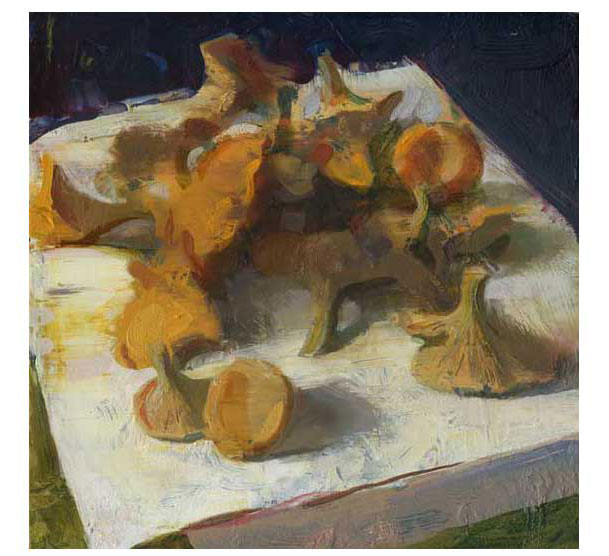
Jon Redmond, Chanterelles, 10 x 10 inches Oil on Board
click here for a larger view
Jon Redmond is a Pennsylvania based painter who is currently has one person show of new work at the Sommerville-Manning Gallery This show is up until October 12. Jon Redmond studied at the Pennsylvania Academy of the Fine Arts 1987-1991 and the University of Delaware, 2001-2003 where he received his MFA. See his website for more information.
The September 2013 edition of the American Art Collector has an article, Jon Redmond – Brandywine Valley, in which the writer, Dr. David Nalin, stated:
Redmond paints the familiar surroundings of Chester County not because they’re innately and overwhelmingly beautiful but because he seeks beauty in the everydayness of his life. Familiarity develops a practiced eye that sees the artistic promise of an ordinary scene. WC Laundry couldn’t be more mundane. Laundry hanging on the line strung down the length of the garden is a common sight but the practiced eye saw the contrasts and relationships of color, form and light. Redmond paints quickly on his small wood panels in an alla prima style, wet paint on wet paint and finished in one sitting. The thick rapid brushstrokes eventually dry and stabilize, but the energy of the moment is preserved.
There is also another, interview with Jon Redmond on the Art Room Online that is an excellent read and discusses his background, process and interests at length.
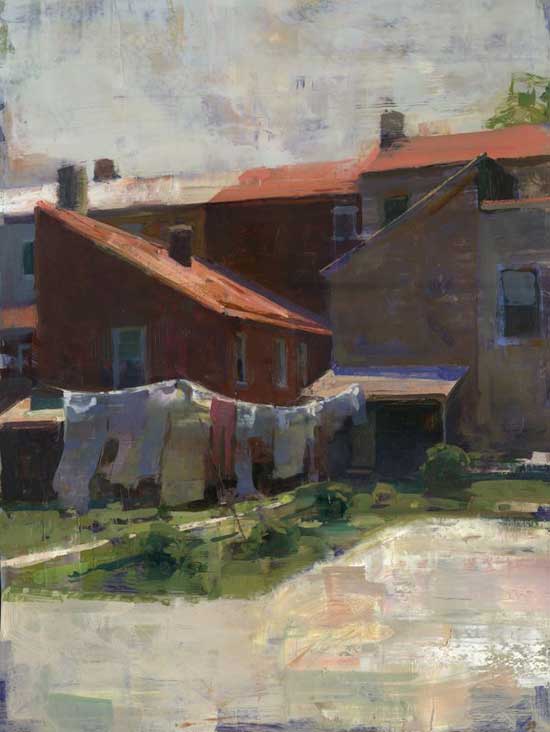
Pink Pants 28 X 20 inches Oil on board
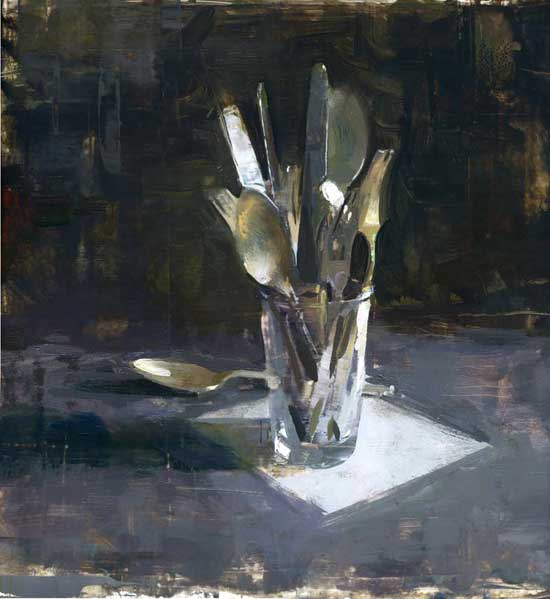
Silver Oil on Mylar, 18 x 16 inches
LG: What are some of the most important considerations for you in making a painting? Can you tell us something about your work process?
JR: The most important thing is that I am excited about what I see. Most of the time what excites me is not the most obvious subject, like a landmark building or dramatic view, but something pretty simple like a patch of sunlight or the arrangement of a space between two houses. I don’t do sketches because I feel it saps the energy from my paintings. In fact I don’t even sketch on the canvas. I start by laying large masses down. I hate line. I want to do the searching and struggling while I am painting because that is what makes the painting become interesting, the process of searching. lines would restrict my painting in a negative way by dictating where things are going to happen in the beginning of the process when you really don’t know that much about what needs to happen. Lines also tend to make you pay attention to the wrong visual relationships. What is important is what is happening on ether side of where a line would be, and by putting a line down you tend overlook the importance of a relationship between two colors or values (the line I feel, becomes a lazy solution to a visual question) Painting for me is really just a legal excuse to sit and look at something for hours on end. What other profession allows you to go out, find something really cool and stare at it as long as you want?
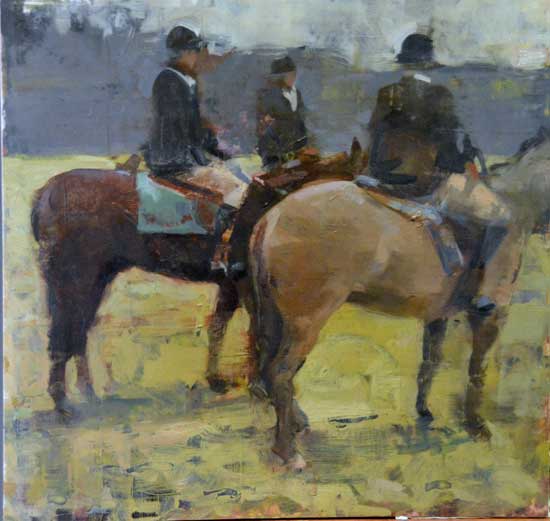
The PLAN 19 x 20 inches oil on board
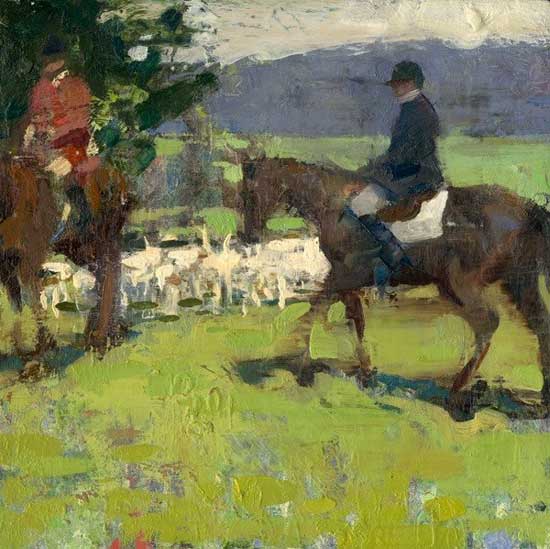
Hounds 10x 10 inches oil on board
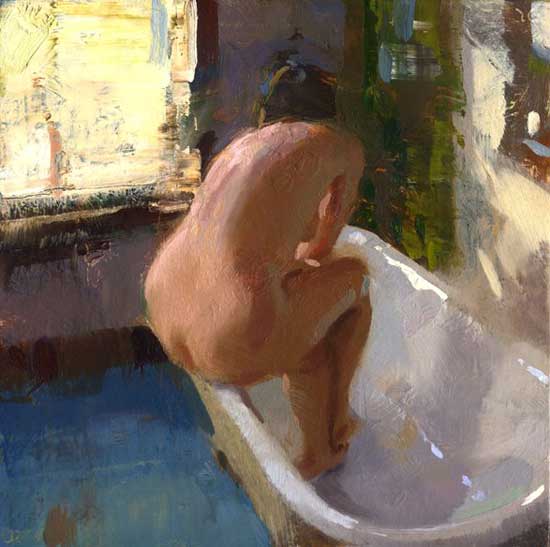
Nude in Tub 8 x 8 inches oil on board 2011
LG: Degas must be an important influence with your work, especially your horse and figure paintings. Please tell us something about how these paintings came about.
JR: I try not to look at too much work from other artists while i am working on my own paintings, so I tend to look for ideas and inspiration between periods of painting. I don’t paint all the time but go through periods of intense work and then periods of “other work” that is: reading, framing, ceramics, photography, working on my house, bike riding, traveling, what ever. But the period of “other work” is totally necessary to my painting process. I used to feel guilty about not painting all the time but this method seems to work for me. Before I started my nude series I started looking at more Degas. I like his nudes because I love the way that they feel as if you just opened the wrong door and are seeing something you where never supposed to look at. I also enjoy the way you can feel him working on his paintings. He doesn’t try to hide his process and often leaves unfinished areas in his work.
The nudes and horse paintings just came about as I was getting bored with landscape and wanted to look at something new. I did’t want to try to make up some lame excuse to paint a new subject so I went with the most accepted painting subject in all of art history, the nude. I liked that peeping Tom quality of Degas and set the nude in the bath because of course that is where a nude should be. I hate poses so I asked my model to just do what she would do if she where getting ready to take a bath. And the tub. The tub was taken out of a great old hotel in Philadelphia that I painted in, and I enjoyed painting that tub as much as the model. The contrast of the way light slides across the concave tub as apposed to convex model was great to look at. The horse paintings where the same. Just looking for something new to study and my studio is located in fox hunting country so….
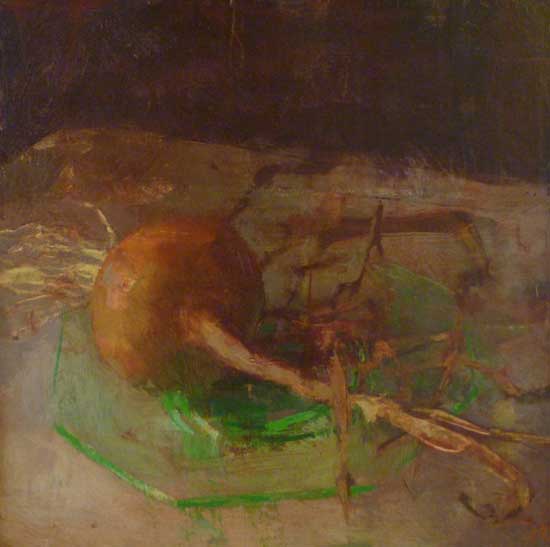
Onion on Green Glass, 10 x 10 inches oil on panel 2012
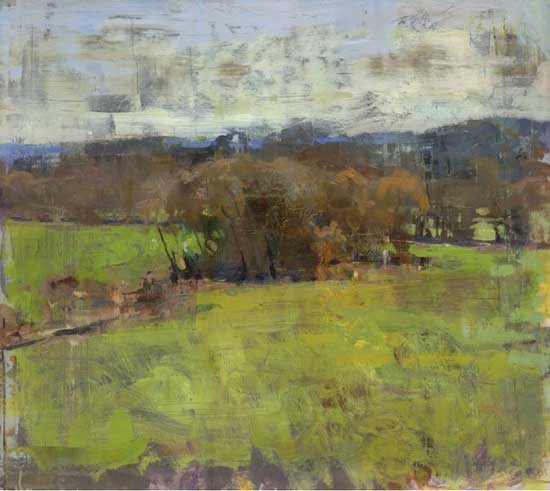
The End of Grey 20 x 21 inches oil on board
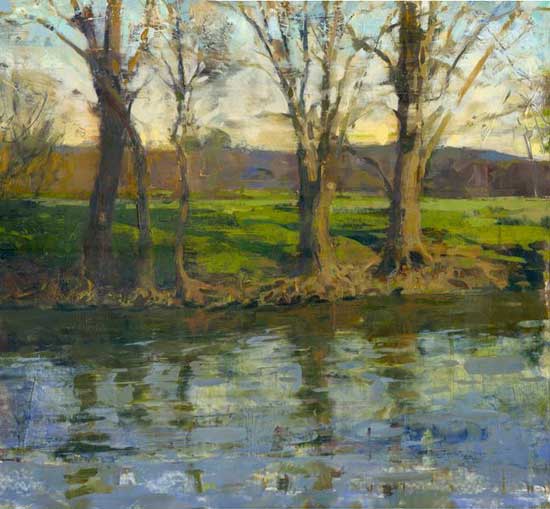
Brandywine Bank 20 x 21 inches oil on board
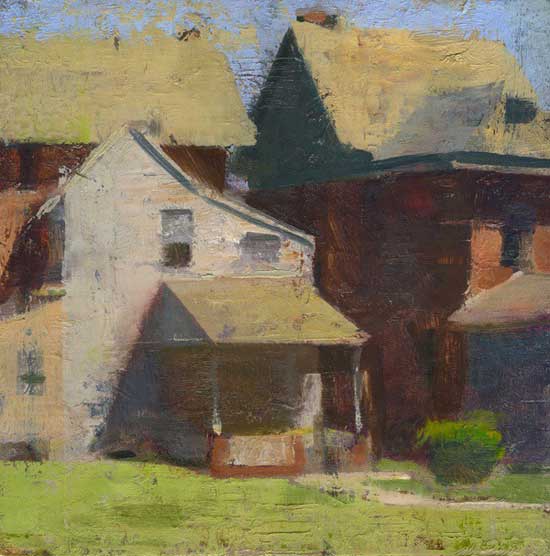
West Chester (evening light) 10 x 10 inches oil on board
LG: How important is observation to your painting? How important is it for you respect the specific subject you’re painting? How far will you go in deviating from what you see for the sake of the painting?
JR: Like I said before painting is an excuse to look, but I am not a slave to my subject. My main goal is to make an interesting object, so I am free to change/add whatever I feel necessary. The subject is not important. The painting is what’s important.
I have been doing more work in the studio lately and have found that using photos in conjunction with direct observation frees me up to paint more. I no longer have to wait for the right weather or light and don’t have to pose a subject.
I do however feel that lots of direct observation is needed to understand how to work well from photos. Photos are missing a lot of information. They see only as a camera sees which is very different from how we observe the world through eyes. You should not rely on having a camera do your editing for you. I discourage my students from learning to paint from photographs because they just learn how to copy a photo and what is the point of that?

West Chester Triptych 10 x 31 inches oil on board
Apples, 10 x 10 inches oil on board
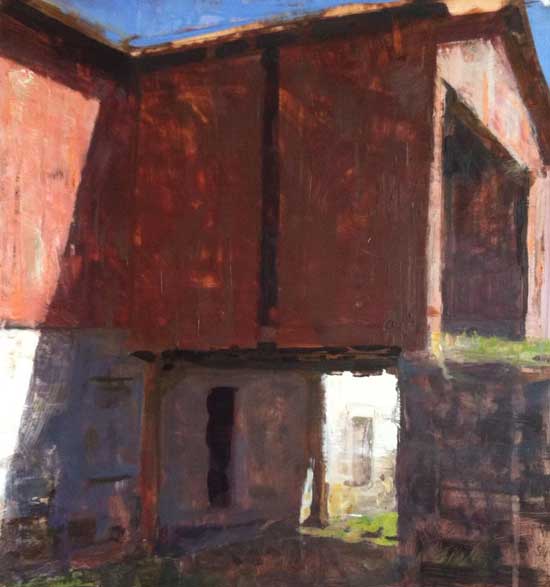
Barn Painting 19 x 18 inches oil on board
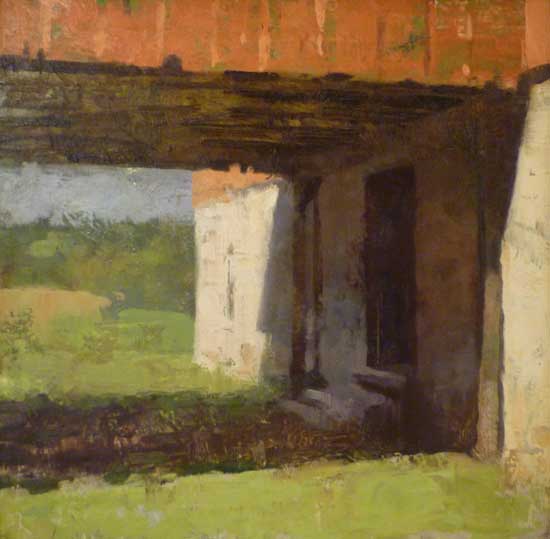
Bank Barn, 2012, 10 x 10 inches oil on board
LG: Your color seem more more about getting rich tonal relationships than color sensations. Your tones have a gutsy, earthy quality to the light that gives a punch and weightiness to the work. For instance your barns seem substantial, strong enough to hold hay, horses and manure unlike a vaporous Wolf Kahn that dissolves in the light and atmosphere.
You once said in a previous interview that: “You have to work around the limitations of paint. Paint can never replicate the wide range of values and colors that we see with our eyes. The key then is to make things feel correct rather than trying to match individual colors and values. Value I feel is much more important than color so trying to get my values to make sense is the most important part of the painting process.”
My question to you here is: Why attach greater importance to value over color? Is this simply a matter of artistic leanings, style and preference? Why can’t striving for the right colors and right tones have an equal importance?
JR: They can I suppose, but in my experience values become important in representational painting because value defines form. You can easily understand a black and white photograph which shows you that color is unnecessary. Change the value of something and you end up changing the form. Change the color and you just end up changing the color. I don’t want you to think that color is not important to my work because it is, but I feel that if I don’t get my value relationships right all the color changing in the world will not help the painting one bit. Getting the values working frees you up to do what ever you want with color because the painting holds together with it’s proper value relationships. I usually lay down some kind of loose monochromatic underpainting with thin transparent paint before I get into messing around with my color.
Also, I think I respond more to value relationships than to color ones. I find it important to get strong contrasts in my work and find it frustrating to paint on cloudy or hazy days because everything becomes so close in value.
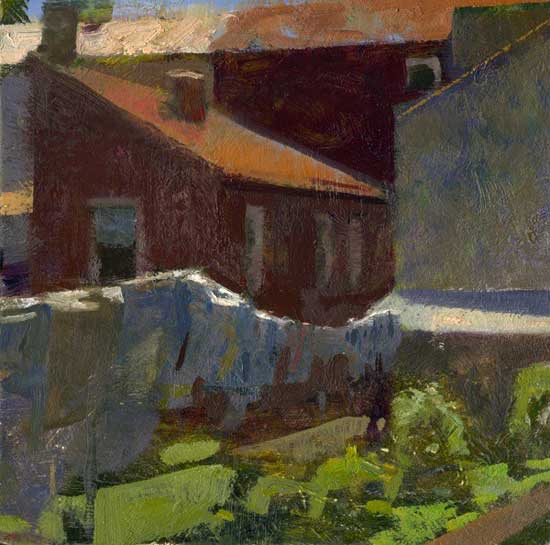
West Chester (laundry) 10 x 10 inches oil on board
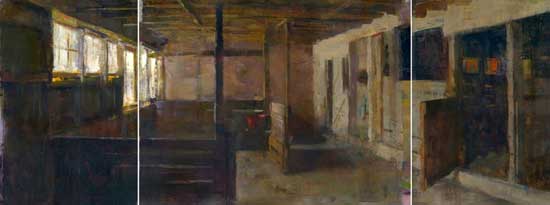
Barn Triptych 20 x 38 inches oil on board
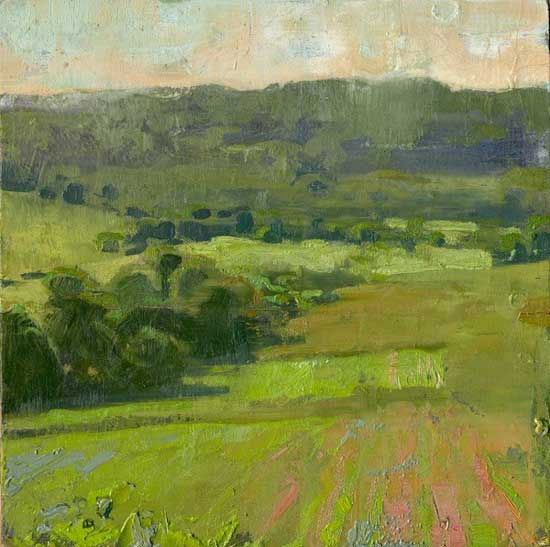
Wawaset 10 x 10 inches oil on board
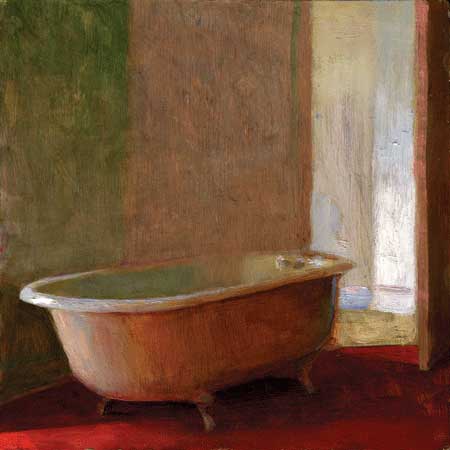
517, 10 x 10 inches oil on board
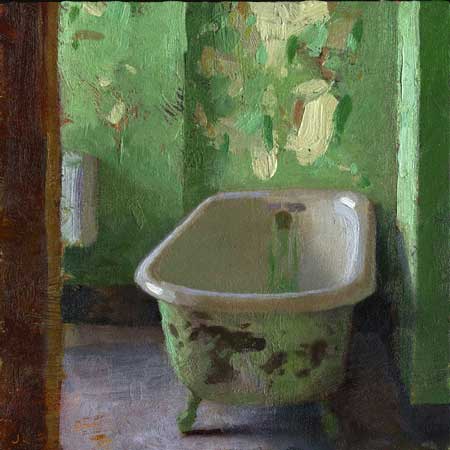
614, 10 x 10 inches oil on board
LG: Painting from nature is often considered old-fashioned, but many new fabulous representational painters continue in this vein despite the art world’s kibosh. What does it mean to be a contemporary painter for you? With galleries and museums showing a nearly limitless range of taste, style, skill and meaning; is being a contemporary artist still important or even relevant today?
JR: Every artist is a contemporary artist whether they like it or not. The problem is that some artists don’t like it and choose to hang on tightly to the way artists worked in the past as if those artists had the best and only way of making art.
I think that you should learn by looking at past and present artists and then try to discover you own methods of making an object that expresses your own sensibilities. If you try to be “contemporary” your work will suffer. We are contemporary by being alive today, so why work so hard at it? You just need to be honest to your own ideas and not try to recreate someone else’s. I think that artists who rely on strict methods and ideas from the past just simply don’t have any ideas of their own worth expressing, and would be better off spending their time attending Civil War recreations and Renaissance fairs. Not to say that one has to find some new novel way of creating a painting, but you have to search out your own path, look at your own personal world and use what ever it takes to try to convey to the viewer what it was like to be YOU, a painter alive in the 21st century.
LG: In your previous interview you stated: “… It is not so much about how beautiful the landscape is to begin with but more how I can find beauty in something that is part of my everyday life.” For the sake of argument; why should painters care about Beauty and why should we care about what’s in the artist’s everyday life?
JR: Well, what we just talked about before touches on this issue. If you are not expressing your everyday life, what are you expressing? Someone else’s?
I suppose you could be making up some fantasy life and painting it but that is not the way I work. I paint in a kind of search for understanding. What is it like to be alive and look through my eyes and think with my brain. Beauty is a very personal thing. You should find your own beauty and not think about other peoples definitions. Some artists find it in flowers and some in cadavers. That is not to say that you should just look randomly at the world and paint everything you see, but try to find some aspect about life that strikes you as the most interesting, and then spend your life obsessively studying it. For me that aspect is light and how I see it affecting what is around me and how that affects me. A great work of art for me, is when I somehow get a sense of what can be beautiful, interesting or meaningful, simply by viewing some aspect of life through another artists brain.
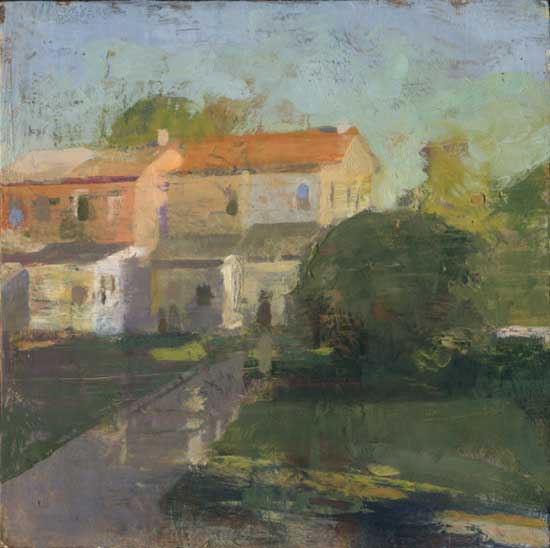
West Chester Backyards, oil on board, 10 x 10 inches
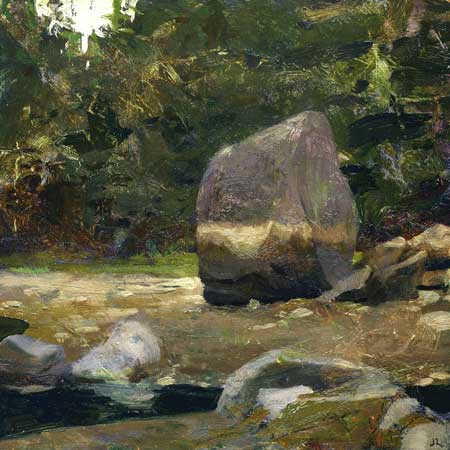
Rock, 10 x 10 inches oil on board
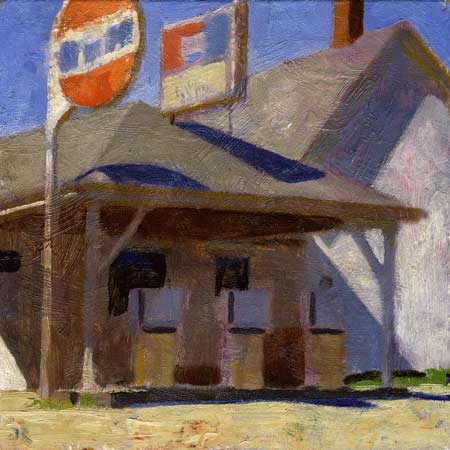
Grays Corner, 10 x 10 inches oil on board

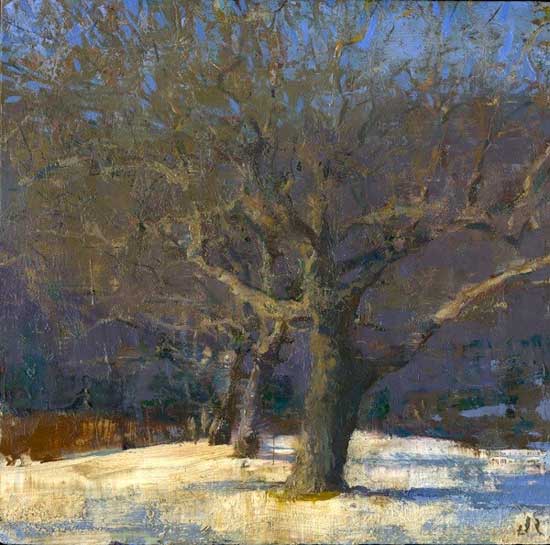
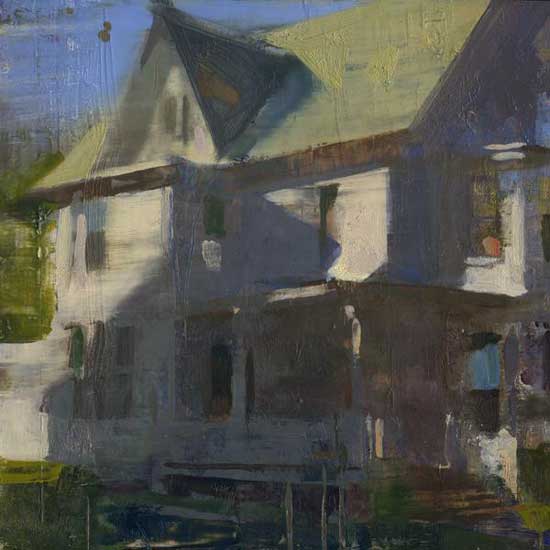

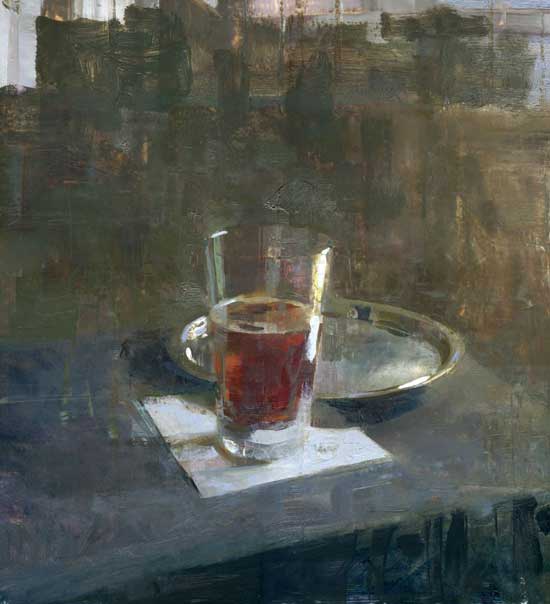




Great painter, interesting interview. If you’re anywhere in the area, you should go see the show.
Powerful and poignant !
Wonderful work!
Intimate and elegant, a bit nostalgic too.
Like these paintings , no. LOVE these painting? YES, YES, and again YES. Having one hanging on my wall?? An ABSOLUTELY an YES!!
One of my favorite painters. Thanks for the great interview.
Loved the interview and the work. I found myself nodding in agreement with what Jon was on about in terms of light and the way he develops his ideas and solves the painting problems. His ideas about line were intriguing and something that I’m thinking is the similar to massing the forms.
Thank you for this wonderful interview and exposing me to this mans work.
Wonderful work – and I appreciate what Jon said about the importance of getting the values right. It’s so evident in his work – the value relationships are striking. And there’s so much weight in his warm palette. Fantastic! Thanks so much!
hi John- these paintings are really beautiful.thank you for allowing me to visit your class at Wayne every Tuesday. hope to take your class in the future. Sarah DuBois
After Seeing Jon’s 4 painting images in Al Gury’s 2nd book, I just had to go on-line to learn more about this most outstanding artist’s thoughts and see more of his work.
I would like to see him published in his own book, and in more art magazines.
Thanks so much, Jeffrey.
Elizabeth
Sorry I got the name wrong. I meant to thank the interviewer – Larry, not Jeffrey
I like the interview .